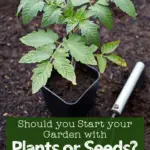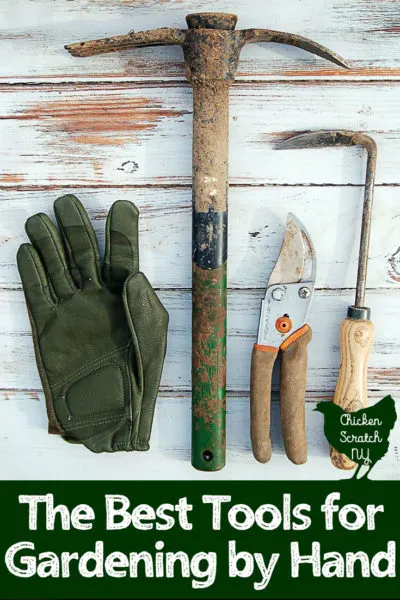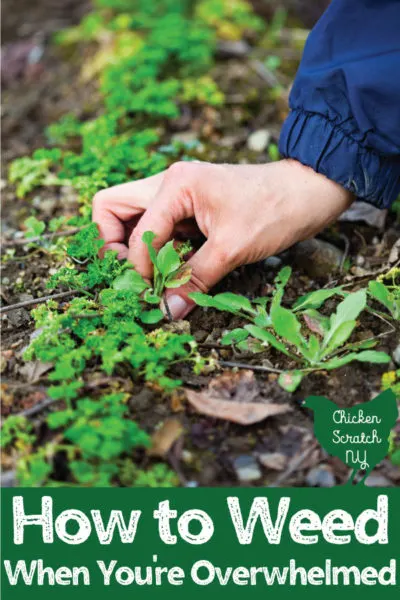Growing from seed and starting with purchased plants are both great ways to start a vegetable garden. Both methods have advantages and disadvantages and it’s up to you to decide what is right for your garden goals.
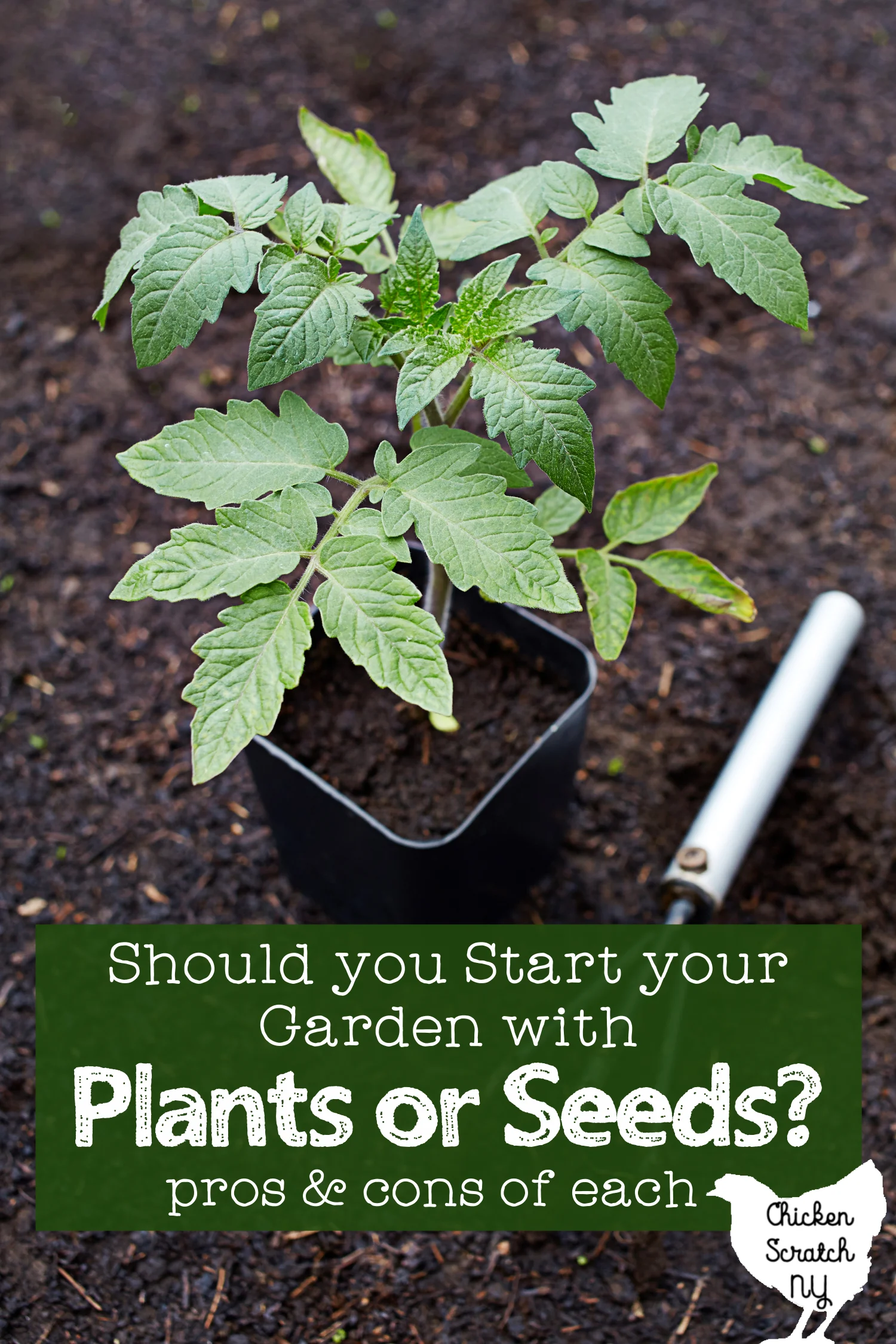
Planning and planting a vegetable garden can be overwhelming for anyone. Knowing whether it’s better to buy started plants or grow your own from seed is a huge stumbling block.
Personally, I use both methods for planting my garden for different reasons. I think a huge problem with starting a vegetable garden is the idea that you have to do it all; you need to start everything from seed, you need to grow all of your families food and you need to do it all in a Pinterest perfect garden with a smile on your face.
Read more about Setting Your Garden Up for Success (3 Things to Avoid)
That’s not going to happen, probably not ever but certainly not your first year. Any garden is better than no garden!
There is nothing wrong with making things easier on yourself.
There are a lot of garden crops that don’t transplant well, either because the seedlings are delicate, the taproots resent being disturbed, or because they’re prone to transplant shock. This post is not about those, it’s about the
Benefts of Growing from Seed
With that out of the way, most of the things I grow are grown from seed. I have a big garden every year and I’ve put a decent amount of money into growing my own seedlings.
Bigger Variety when Growing From Seed
This is the number one reason I like to grow my food from seed. I have a low-key obsession with oddly colored vegetables and growing things with a fun history.
When you grow your own tomatoes or pepper or even cabbages from seed you have a whole world full of options! When you’re picking up a six-pack at a greenhouse you’ll probably have 2-4 tomato options, a bell pepper, a jalapeno, and one kind of storage cabbage.
You could literally grow 5 new tomato varieties every year and not get through them all before you die.
Read more about Different Kinds of Tomatoes
Seeds Last for Multiple Years
Seeds are easy to store and it’s a good feeling knowing you’ve got an entire year’s worth of food stashed in a box in your bedroom.
Most seeds last for several years when kept cool and dry. That means that $2 packet of tomato seeds can set you up for a few years.
Read more about Ordering Seeds
2020 was a rough year in a lot of ways, one thing I’d never seen before was seed companies (and greenhouses) running out of plants and seeds. I was really thankful I had those seeds in my back pocket waiting for me.
More Control
There are specific times for stating seeds, they’re usually based on your last frost date and it’s different in every area regardless of you growing zone.
Read more about Why Your Growing Zone Doesn’t Matter in the Vegetable Garden
If you’re buying your started plants from a big box store they were likely all started at the same time and that probably isn’t the best time frame for your specific location.
Plants that are started too early can end up stunted in the long run and are more likely to be affected by transplant stress.
You also have more control over the soil you use and any fertilizers or pesticides you add. I use organic seed starting mix and water my older seedlings with diluted fish emulsion.
I can plant my seedlings out in the garden and know with 100% certainty that they don’t have an neonicotinoid pesticides on them ready to wipe out my bees and native pollinators.
Cheaper in the Long Run
Starting seeds has a pretty big upfront cost if you’re investing in lights and trays and/or a greenhouse space. But if you are growing a lot of plants and you’re doing it for a lot of years you’ll end up ahead doing it yourself.
I purchased professional quality 1020 seedling trays and I’ve been using the same ones for years. They cost about $35 for a set of 10 72-cell plug flats and seed trays.
One year of starting my own tomatoes, peppers and basil plants made up for that cost.
Disadvantages of Starting from Seed
Of course there are two sides to every coin and starting from seed isn’t always the best choice.
Seed Starting is a Time Commitment
Depending on what you’re growing you might need to start your seeds 12 weeks ahead of your last frost date. That’s 3 months of devoting a potentially large area of you home and your time to the plants before you even get into garden.
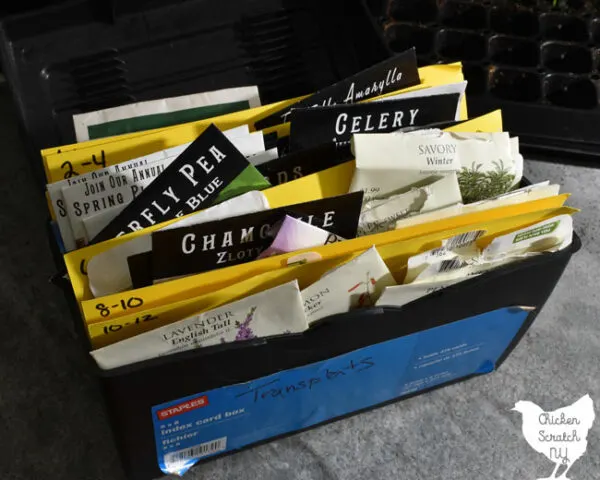
I used to have a large table in my craft room where I set up my grow lights and heat mat, then I lost my mind in quarantine and bought a quilt frame. Now I’m struggling to find a place where I can get my seeds started where my cat can’t murder them.
Speaking of murder, it’s a real knife in the heart to put months of effort into a seedling only to lose it when your 22 pound cat feels like salad. When you’re setting up a seed starting area make sure you can keep any pets away from your plants.
Set Up Costs are High
The other big issue with starting your own plants from seed is the setup costs. I have a large grow light, I can easily fit 4 1020 trays underneath it and it was not cheap!
The light I bought was $150 when I purchased it and the same light is around $200 now. I made a stand to hold it up but you might prefer investing in a rack system (yet another expense).
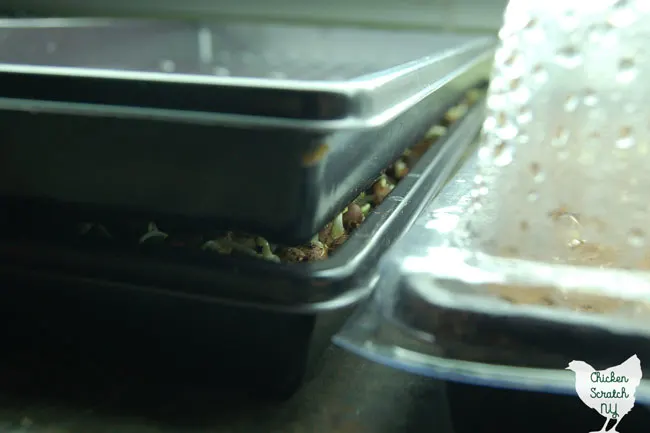
Along with that, you’ll want a seedling heat mat (I have a seedling heat mat that fits two 1020 flats, you can get one that holds one flat or up to 4 flats) for more uniform germination.
I know some people put their trays on top of the fridge and that works but my house is usually too cold and I get better results with the heat mat.
You’ll also need something to grow your seeds in, I use the same greenhouse flats year after year but there are lots of DIY options from using eggshells to homemade paper pots. And finally you’ll need seed starting mix, either purchased or homemade and your seeds.
The good news is that the light, light rack, heat mat, and potentially your flats can be reused year after year. They can also be used for growing microgreens and sunflower or pea shoots. The bad news is that bill really ads up during your first growing season.
Read more about How to Grow Pea Shoots
Benefits of Starting with Plants
I’m lucky to live in an area with tons of small independent greenhouses. I start visiting as soon as they open, usually late spring a month or so before our last frost date.
More than once I’ve ended up there scrambling for something that either I killed, the cat murdered or the garden rabbit colony ate. It’s almost always broccoli for me.
Any garden is better than no garden, so don’t feel bad if you can only find plants in a big box store. I’ve certainly brought home my share of sale rack perennials from Lowe’s.
It’s Easy to Buy Plants
There is no way around this, it’s so easy to walk into a greenhouse, pick up a plant, throw down some cash and walk away with a new plant friend.
If you aren’t limited by a budget and you are ok with a generic plant selection this is a great way to get a garden going.
Some people could argue that it’s too easy, my overflowing flower beds learned that lesson when quarantine stress shopping led me to bringing home all sorts of fun perennials.
You Can* Start with Healthy Plants
A lot can go wrong with starting your own seeds, especially if you’re doing it without a good light source. I’ve seen many trays of leggy, pale, sad seedlings started next to a window.
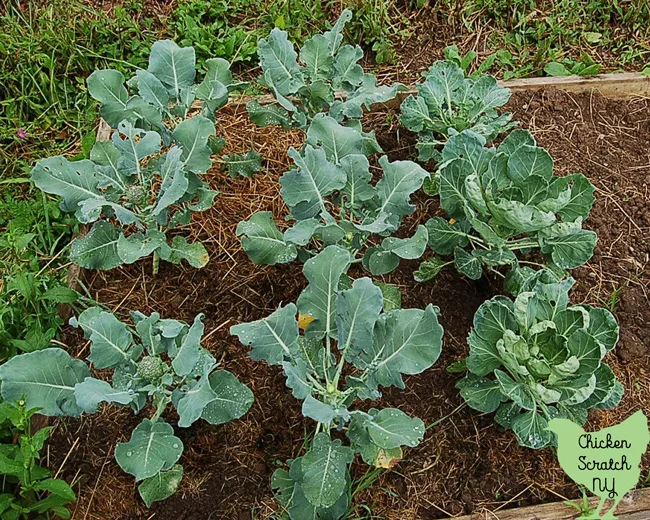
Plants grow best when they are given what they need to grow quickly, that means the right amount of light, water and fertilizer. If you withhold those from the plants they’re not going to be in great shape when it comes time to move them into the garden.
Getting your plants when they’re young and healthy from a greenhouse can really set you up for success. As long as they’re healthy.
It’s also possible to get sickly, overgrown, root bound, stressed almost to death, and even diseased plants from a greenhouse. Most of the time you’ll be ok if you buy the plants young and make sure they’re not root bound.
Hardened Off
The most obnoxious part of starting your own plants from seed is the hardening off process. Hardening off is the gradual process of move the seedlings from under the lights out into the real world.
Life under a grow light is pretty cozy and switching up the controlled environment for direct sunshine and wind can be hard on a plant. Hardening off is where I usually mess up my seedlings.
Last year the geese ripped all the tags out of my flats and ate my starting-seeds-in-eggshells experiment. I always forget to bring in something before a frost and living in a wind tunnel has led to more than one flat taking flight.
When you buy your plants from a greenhouse that step has already been taken! You still need to keep frost sensitive plants safe from the cold but you get to skip the slow process of moving from grow lights to shade to a few hours of sun to full sun.
Disadvantages of Starting with Purchased Plants
Just to even things out we have to cover the disadvantages of starting with purchased plants. If you’ve read the rest of this post you’ll be able to guess everything I’m going to say here but I’m going to say it anyway.
High Cost per Plant
There is no way around this, buying plants is more expensive than a packet of seeds. If you want to plant 20 tomato plants, that’s going to add up.
I try to save my plant purchases for things that I/my cat have killed or things that look really fun. At this point other than my yearly replacement broccoli I don’t but many vegetables, I save my money for fruit trees.
Lower Variety
Unless you’re really lucky and you have a local greenhouse that starts it’s own odd ball varieties you’re looking at a very predictable garden every year.
You’ll get one slicing tomato (usually a Better Boy or Best Boy or some other type of boy), one cherry tomato, maybe a paste tomato, one bell pepper, and a jalapeno or habanero pepper.
No Control
When you buy a plant that’s been grown by someone else you have no control over when they were started or how they were grown.
If you’re looking to have a 100% organic garden you might struggle to find seedlings that haven’t been dosed with non-compliant fertilizer, or you might struggle to find flowering plants that you know 100% were never treated with pesticides.
It’s almost guaranteed that you’ll find plants there were started a month or more before they should have been. It’s not ideal, you generally want to let your plants grow quickly and not allow them to be stunted but life isn’t always ideal and you gotta do what you can with what you have.
You Can Miss Out
This is the most avoidable disadvantage. If you plan to plant your garden with purchased starts, you gotta get there early.
Around here Memorial Day weekend is the time to plant your tomatoes and other frost-sensitive plants in the garden. If you hit up a garden center the Wednesday before Memorial Day you’ll find empty shelves.
Everyone has a different situation and different hurdles to overcome when it comes to planting a garden. Whether you’re short on cash or short on a space that lacks a murderous Moose Cat, you have to find a way to work with what you have.
I hope I’ve given you some things to think about when you’re planning your garden without discouraging you!
Check out my Vegetable Garden page for more ideas or start here:

